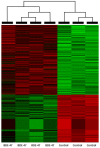Transcriptomic Analysis of Gonadal Adipose Tissue in Male Mice Exposed Perinatally to 2,2',4,4'-Tetrabromodiphenyl Ether (BDE-47)
- PMID: 29596321
- PMCID: PMC6027300
- DOI: 10.3390/toxics6020021
Transcriptomic Analysis of Gonadal Adipose Tissue in Male Mice Exposed Perinatally to 2,2',4,4'-Tetrabromodiphenyl Ether (BDE-47)
Abstract
For the majority of lipophilic compounds, adipose tissue is traditionally considered as a storage depot and only rarely as a target organ. Meanwhile, abnormalities in adipose tissue physiology induced by chemical exposure may contribute to the current epidemic of obesity and metabolic diseases. Polybrominated diphenyl ethers (PBDEs) are a group of lipophilic flame retardants found in the majority of human samples in North America. Their ability to alter the physiology of adipose tissue is unknown. We exposed pregnant mice to 0.2 mg/kg body weight/day of BDE-47 perinatally. Transcriptomic changes in gonadal adipose tissue were analyzed in male offspring using the RNA-seq approach with subsequent bioinformatic analysis. The expression of genes of coagulation and complement cascade, de novo lipogenesis, and xenobiotic metabolism was altered in response to BDE-47 exposure. The affected molecular network included the following hubs: PPARα, HNF1A, and HNF4. These findings suggest that adipose tissue should be considered a target tissue for BDE-47, in addition to its role as a storage depot. This study also builds a background for a targeted search of sensitive phenotypic endpoints of BDE-47 exposure, including lipid profile parameters and coagulation factors in circulation. Additional studies are needed to investigate the role of PBDEs as an obesogen.
Keywords: BDE-47; PBDE; adipose; complement and coagulation cascade; de novo lipogenesis; genomic; metabolism; obesogen; polybrominated diphenyl ether; transcriptomic.
Conflict of interest statement
The authors declare no conflict of interest.
Figures





Similar articles
-
Polybrominated dibenzo-p-dioxins, dibenzofurans, and diphenyl ethers in Japanese human adipose tissue.Environ Sci Technol. 2003 Mar 1;37(5):817-21. doi: 10.1021/es0258780. Environ Sci Technol. 2003. PMID: 12666907
-
Perinatal exposure to 2,2',4'4' -Tetrabromodiphenyl ether induces testicular toxicity in adult rats.Toxicology. 2017 Aug 15;389:21-30. doi: 10.1016/j.tox.2017.07.006. Epub 2017 Jul 13. Toxicology. 2017. PMID: 28712647
-
Developmental Exposure to 2,2',4,4'-Tetrabromodiphenyl Ether Permanently Alters Blood-Liver Balance of Lipids in Male Mice.Front Endocrinol (Lausanne). 2018 Sep 20;9:548. doi: 10.3389/fendo.2018.00548. eCollection 2018. Front Endocrinol (Lausanne). 2018. PMID: 30294300 Free PMC article.
-
Polybrominated diphenyl ethers: human tissue levels and toxicology.Rev Environ Contam Toxicol. 2004;183:55-97. doi: 10.1007/978-1-4419-9100-3_3. Rev Environ Contam Toxicol. 2004. PMID: 15369322 Review.
-
A review on human exposure to brominated flame retardants--particularly polybrominated diphenyl ethers.Environ Int. 2003 Sep;29(6):829-39. doi: 10.1016/S0160-4120(03)00108-9. Environ Int. 2003. PMID: 12850099 Review.
Cited by
-
2,2',4,4',5-Pentabromodiphenyl ether induces lipid accumulation throughout differentiation in 3T3-L1 and human preadipocytes in vitro.J Biochem Mol Toxicol. 2020 Jun;34(6):e22485. doi: 10.1002/jbt.22485. Epub 2020 Mar 4. J Biochem Mol Toxicol. 2020. PMID: 32128945 Free PMC article.
-
Effects of Decabrominated Diphenyl Ether Exposure on Growth, Meat Characteristics and Blood Profiles in Broilers.Animals (Basel). 2021 Feb 22;11(2):565. doi: 10.3390/ani11020565. Animals (Basel). 2021. PMID: 33671620 Free PMC article.
-
Exposure to PCB52 (2,2',5,5'-tetrachlorobiphenyl) blunts induction of the gene for uncoupling protein 1 (UCP1) in white adipose.Environ Toxicol Pharmacol. 2025 Jan;113:104612. doi: 10.1016/j.etap.2024.104612. Epub 2024 Dec 13. Environ Toxicol Pharmacol. 2025. PMID: 39674530
-
Obesity II: Establishing causal links between chemical exposures and obesity.Biochem Pharmacol. 2022 May;199:115015. doi: 10.1016/j.bcp.2022.115015. Epub 2022 Apr 5. Biochem Pharmacol. 2022. PMID: 35395240 Free PMC article. Review.
-
Transcriptomic Analysis of the Differential Nephrotoxicity of Diverse Brominated Flame Retardants in Rat and Human Renal Cells.Int J Mol Sci. 2021 Sep 17;22(18):10044. doi: 10.3390/ijms221810044. Int J Mol Sci. 2021. PMID: 34576211 Free PMC article.
References
-
- National Institutes of Health (NIH) Funding Opportunity Announcement: Role of Environmental Chemical Exposures in the Development of Obesity, Type 2 Diabetes and Metabolic Syndrome (R21) National Institutes of Health; Bethesda, MD, USA: 2012.
LinkOut - more resources
Full Text Sources
Other Literature Sources
Molecular Biology Databases

